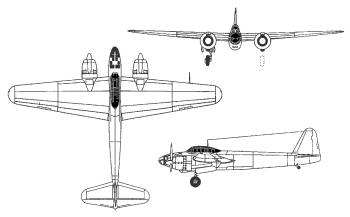



The elegant and attractive Yokosuka P1Y Ginga (Milky Way) was designed as a twin-engined multi-role aircraft similar to the Mosquito or the Ju 88. It was originally intended for the dual roles of level and dive bombing for a 1940 IJN specification but proved to be quite adept at torpedo bombing as well as a night fighter. Its only major defects were unreliable engines which often failed to deliver their rated power and difficult maintenance due to the lack of skilled crew, fuel, and spares as Japan's military fortunes deteriorated. Nevertheless, it was widely praised by those who flew it and had a number of innovative characteristics such as search radar in bomber variants, and obliquely firing cannon on night fighters (later aircraft even had rudimentary AI radar as well). It was also planned to be the parent aircraft for the MXY-7 Okha suicide aircraft. Ultimately, the P1Y ended up being used for kamikaze attacks.
The first of six prototypes of the 'Frances' first flew on August 1943 and entered service rather prematurely as the P1Y1 Model 11a. Some were eventually manufactured as night fighters known as the P1Y1-S while continuing engine problems would lead to the P1Y2 bomber with Kasei engines. Radar-equipped night-fighters were designated P1Y2-S Kyokko (Aurora) although only a trickle escaped production lines. Other parent versions included the P1Y3 parent aircraft for Okha suicide planes, as well as the P1Y4, P1Y5, and P1Y6 with new engines.
Preceded by:
NoneSucceeded by:
None | |
| Design | P1Y1 |
| Name | Ginga |
| Code Name | Frances |
| Type | Light Bomber |
| Year | 1944 |
| Crew | 3 |
| Dimensions | |
| Length | 15 m |
| Height | 4.300 m |
| Wing Span | 20 m |
| Wing Area | n/a |
| Weight | |
| Empty | 7,265 kg |
| Maximum | 13,500 kg |
| Wing Loading | 245.5 kg/m² |
| Performance | |
| Speed | 547 km/h |
| Ceiling | 9,400 m |
| Range | 1,918-5,370 km |
| Powerplant | |
| Engine | 2 x NK9C Homare 12 Nakajima 1,361 kW |
| Thrust/Weight | 0.46 |
| Armament | |
| Guns | 2 x 20-mm |
| Payload | 1,000 kg |
| Production | |
| Built | 996 |
| Total | 1,098 |